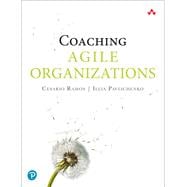"[A] unique view of organizational agility. Cesario and Ilia first describe the [foundational] tools and vocabulary to think about agile enterprise-level change. The second section is a practical approach to adoption. It marries the foundational elements into a people and customer centric approach to change. The book is epic in scope ... but it manages to present a cookbook for agile adoption and change."
--From the Foreword by Dave West, CEO, Scrum.org
"Cesario and Ilia ... understand that a key element of successful change to being adaptive at scale is Organizational Design (OD)--and that OD is something senior managers need to own, master, create, and lead, not delegate. ... [F]ast delivery and learning isn’t enough at scale. Without other adaptive OD elements in place, there might not be any concrete change. ... [A] wonderful book from two passionate people with years in the trenches involved in large-scale adaptive development."
--From the Foreword by Craig Larman, co-creator, Large-Scale Scrum (LeSS)
For Agile to succeed at scale, strategy, structures, processes, reward systems, and people practices must align with and reinforce each other across the entire organization. Creating Agile Organizations is about making that happen. Whether you're a leader, Scrum Master, or trainer, this book will help you use effective Organizational Design (OD) to achieve successful Agile transformation at the enterprise level.
Drawing on years of experience scaling Scrum, renowned Large-Scale Scrum (LeSS) experts Cesario Ramos and Ilia Pavlichenko present proven techniques for use with any technology, in any large environment. In the context of a true systems-thinking approach, they provide specific solutions for challenges such as preparing and facilitating large-scale Scrum meetings, honing newly relevant leadership skills, and addressing challenges that cut across the entire organization.
This book includes a library of tested tools for effective Agile leadership, including Product Definition Guides for describing any new product and a Feature Heat Map for designing teams and entire organizations.
- Organizing for adaptability, making strategic optimization choices, and choosing informed tradeoffs
- Exploring and applying proven OD principles at the leadership level
- Taking a birds-eye view of the activities most crucial to large-scale adoption
- Coaching to make Agile transformation successful across your organization
- Planning, designing, and facilitating Agile workshops that work
- Preparing and launching highly effective, well-aligned Product Groups
- Coaching teams and guiding product ownership in large groups








